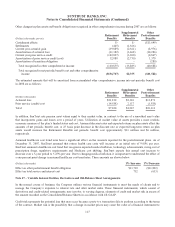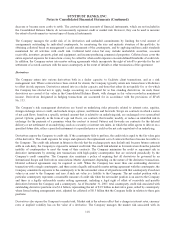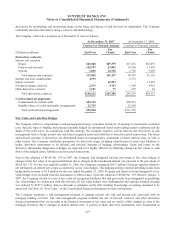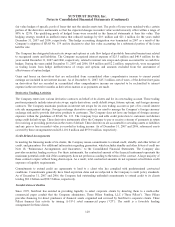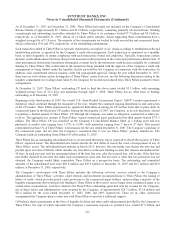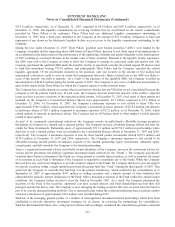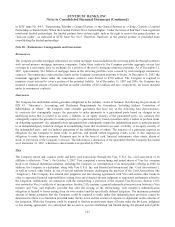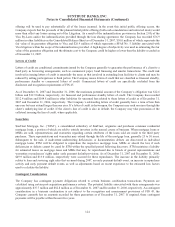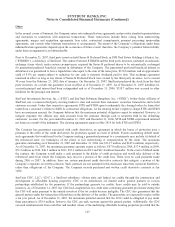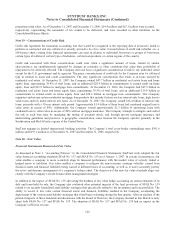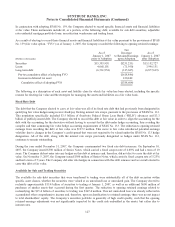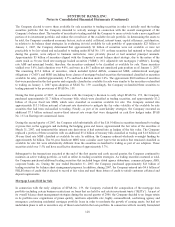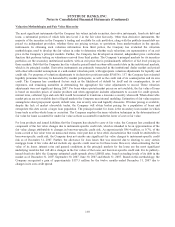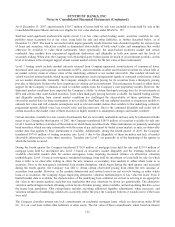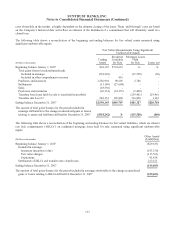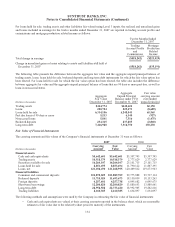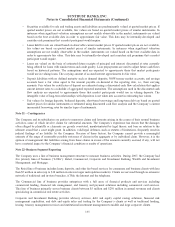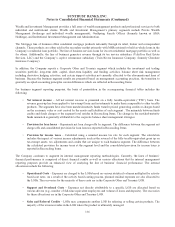SunTrust 2007 Annual Report Download - page 138
Download and view the complete annual report
Please find page 138 of the 2007 SunTrust annual report below. You can navigate through the pages in the report by either clicking on the pages listed below, or by using the keyword search tool below to find specific information within the annual report.SUNTRUST BANKS, INC.
Notes to Consolidated Financial Statements (Continued)
properties retain value. As of December 31, 2007 and December 31, 2006, $14.4 million and $15.3 million were accrued,
respectively, representing the remainder of tax credits to be delivered, and were recorded in other liabilities on the
Consolidated Balance Sheets.
Note 19 – Concentrations of Credit Risk
Credit risk represents the maximum accounting loss that would be recognized at the reporting date if borrowers failed to
perform as contracted and any collateral or security proved to be of no value. Concentrations of credit risk (whether on- or
off-balance sheet) arising from financial instruments can exist in relation to individual borrowers or groups of borrowers,
certain types of collateral, certain types of industries, certain loan products, or certain regions of the country.
Credit risk associated with these concentrations could arise when a significant amount of loans, related by similar
characteristics, are simultaneously impacted by changes in economic or other conditions that cause their probability of
repayment to be adversely affected. The Company does not have a significant concentration of risk to any individual client
except for the U.S. government and its agencies. The major concentrations of credit risk for the Company arise by collateral
type in relation to loans and credit commitments. The only significant concentration that exists is in loans secured by
residential real estate. At December 31, 2007, the Company owned $47.7 billion in residential real estate loans and home
equity lines, representing 39.0% of total loans, and an additional $20.4 billion in commitments to extend credit on home
equity lines and $12.9 billion in mortgage loan commitments. At December 31, 2006, the Company had $47.9 billion in
residential real estate loans and home equity lines, representing 39.5% of total loans, and an additional $19.0 billion in
commitments to extend credit on home equity lines and $28.2 billion in mortgage loan commitments. The Company
originates and retains certain residential mortgage loan products that include features such as interest only loans, high loan to
value loans and low initial interest rate loans. As of December 31, 2007, the Company owned $16.4 billion of interest only
loans, primarily with a 10 year interest only period. Approximately $1.4 billion of those loans had combined original loan to
value ratios in excess of 80%. Additionally, the Company owned approximately $2.3 billion of amortizing loans with
combined loan to value ratios in excess of 80% with no mortgage insurance. The Company attempts to mitigate and control
the risk in each loan type by managing the timing of payment shock, and through private mortgage insurance and
underwriting guidelines and practices. A geographic concentration arises because the Company operates primarily in the
Southeastern and Mid-Atlantic regions of the United States.
SunTrust engages in limited international banking activities. The Company’s total cross-border outstandings were $591.6
million and $693.1 million as of December 31, 2007 and December 31, 2006, respectively.
Note 20 – Fair Value
Financial Instruments Measured at Fair Value
As discussed in Note 1, “Accounting Policies,” to the Consolidated Financial Statements, SunTrust early adopted the fair
value financial accounting standards SFAS No. 157 and SFAS No. 159 as of January 1, 2007. In certain circumstances, fair
value enables a company to more accurately align its financial performance with the market value of actively traded or
hedged assets or liabilities. Fair value enables a company to mitigate the non-economic earnings volatility caused from
financial assets and financial liabilities being carried at different bases of accounting, as well as to more accurately portray
the active and dynamic management of a company’s balance sheet. The objectives of the new fair value standards align very
closely with the Company’s recent balance sheet management strategies.
In addition to the impact of SFAS No. 159 alleviating the burdens of fair value hedge accounting on certain elements of its
debt and loans held for sale, the Company also evaluated other potential impacts of the final provisions of SFAS No. 159
related to its recently formulated asset/liability strategies that specifically related to the investment and loan portfolios. The
ability to record at fair value certain financial assets and financial liabilities resulted in the Company accelerating the
deployment of the various asset/liability strategies that it had been evaluating during the first quarter. After an analysis of the
potential impacts of these standards and discussions with the Board of Directors, the Company decided in late March to early
adopt both SFAS No. 157 and SFAS No. 159. The adoption of SFAS No. 157 and SFAS No. 159 had no impact on the
Company’s effective tax rate.
126



